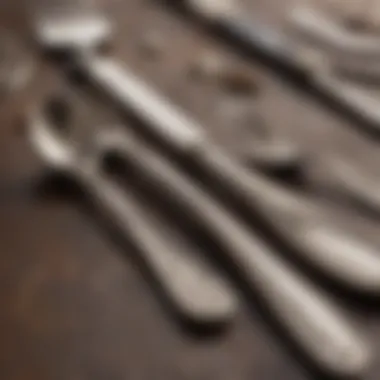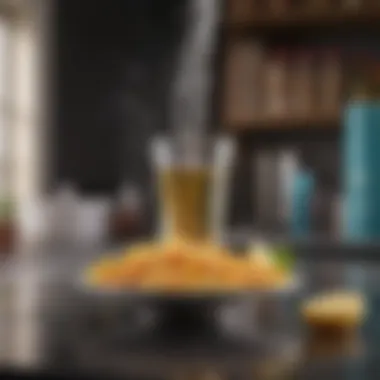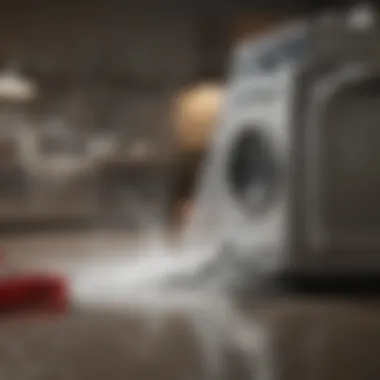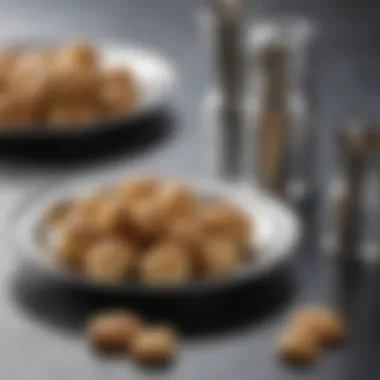Expert Techniques for Immaculate Silver Cleaning


Intro
Cleaning silver is a task that goes beyond mere aesthetic enhancement. It is essential to understand the nature of silver as a material and the various methods available to maintain its luster and integrity. Silver tarnishes due to a chemical reaction with sulfur compounds in the air, which creates a layer of silver sulfide on its surface. This can be problematic for those who wish to keep their silver items looking pristine.
In this article, we will delve into the complexities of cleaning silver, exploring both home remedies and professional techniques. We will cover the chemistry behind tarnishing, practical methods for cleaning, and important considerations to preserve your silver items. By the end, readers will have a thorough understanding of how to effectively clean silver and maintain its allure.
Preamble to Silver Cleaning
Understanding Silver and Its Properties
Silver is a soft, malleable metal known for its conductivity and aesthetic qualities. Its atomic number is 47, and its unique properties make it a popular choice for jewelry, cutlery, and decorative items. Importantly, silver is susceptible to oxidation, which occurs when it reacts with sulfur-containing compounds in the air. This reaction leads to the formation of silver sulfide, manifesting as tarnish.
Tarnishing is a chemical process and can significantly alter the appearance of silver. Thus, understanding silver's properties, including its reactive nature, is crucial for selecting appropriate cleaning methods. Using abrasive or harsh chemicals can lead to scratching or further deterioration of the silver surface.
Common Causes of Silver Tarnishing
Several factors contribute to tarnishing in silver items:
- Exposure to Air: Silver tarnishes faster in environments with higher humidity and pollutants.
- Contact with Sulfur Compounds: Common substances such as rubber bands, certain foods, or even wool can release sulfur gases, accelerating tarnishing.
- Chemical Reactions: The metal's reaction with acids or salts can also cause tarnish over time.
Being aware of these factors is vital for silver care. By taking proactive measures to limit exposure to harmful substances, one can significantly reduce the frequency and severity of tarnishing.
"Proactive care is essential to reduce tarnishing and maintain the beauty of silver pieces."
Preliminary Considerations Before Cleaning
Cleaning silver items is not merely a routine activity; it involves careful thought and assessment. Understanding the character and condition of the silver before choosing a cleaning method is crucial. This section addresses several important considerations that will help individuals make informed decisions in the cleaning process.
Assessing the Condition of Silver
Before diving into any cleaning efforts, one must assess the current state of the silver. Examine for tarnish, scratches, or any other signs of damage that may have occurred over time. Tarnishing is a natural process, and its severity can vary. Observe if the tarnish is thick or has a gritty texture; these attributes can affect which cleaning methods are suitable.
If the silver shows signs of deep scratches or pitting, harsher abrasives may not be recommended. Instead, a gentler approach could preserve the item’s integrity. Being aware of the condition will guide in selecting an effective cleaning technique.
Identifying High-Value vs. Sentimental Items
In the realm of silver possessions, not all pieces hold the same value. Some items may be family heirlooms or possess significant sentimental value, while others might be purely functional. Identifying these categories is essential prior to cleaning.
For high-value silver items, a conservative cleaning method is often preferable to avoid decreasing their worth. It is advisable to seek professional cleaning services for antiques or valuable collectibles. On the other hand, sentimental items may not require the same level of concern. Understanding the value ascribed to each piece will inform whether to take a self-cleaning approach or spend more resources on professional help.
Choosing the Right Tools and Materials
Selecting the correct tools and materials for cleaning silver is critical to protect its surface and finish. Using inappropriate materials can lead to scratches or stripping of the silver coating. Common tools include soft cloths, non-abrasive pads, and specific cleaning solutions designed for silver.
Traditional silver polish can be effective for general cleaning, but homemade solutions, such as baking soda or vinegar, may also deliver satisfactory results without harsh chemicals. Always read labels on commercial products to ensure that they are intended for silver cleaning. Consider the eco-friendly options available that are gentle yet effective.
Key Consideration: Before starting the cleaning process, gather all necessary tools and materials to avoid interruptions that can lead to mishandling of the silver items.


Methods for Cleaning Silver at Home
Cleaning silver at home is an essential topic covered in this article. Understanding effective methods not only preserves the aesthetic appeal of silver items but also extends their lifespan. Many individuals possess silver items that hold both financial and sentimental value, thus fostering a steadfast commitment to their upkeep. Home cleaning methods often utilize everyday ingredients, making them accessible and cost-effective. Additionally, these techniques are generally safe for both the user and the silver itself, provided proper care is taken.
Using Baking Soda and Water Paste
Baking soda is a common household item, valued for its versatility. For cleaning silver, it can be mixed with a small amount of water to create a paste. The abrasiveness of baking soda helps remove tarnish effectively while remaining gentle enough not to scratch the surface.
To apply this method, follow these steps:
- Mix three parts baking soda to one part water until a thick paste forms.
- Use a soft cloth or sponge to apply the paste on the silver, gently scrubbing in circular motions.
- Rinse thoroughly with warm water and dry with a clean, soft cloth.
This method is not only effective but also non-toxic, making it suitable for frequent use.
The Role of White Vinegar in Cleaning
White vinegar is another accessible cleaning agent that can restore the shine of silver items. Its acidic nature enables it to break down tarnish and other stains. To utilize white vinegar, one can dilute it in water and soak the silver pieces.
Here’s a simple way to use this technique:
- Mix equal parts of white vinegar and lukewarm water in a bowl.
- Submerge the tarnished silver for around two to three hours.
- Gently remove any remaining tarnish with a soft cloth before rinsing with water.
Using white vinegar can be a remarkably efficient method, especially for extensive tarnishing.
Employing Toothpaste for Polishing
Toothpaste, a commonplace item in many households, serves a dual purpose for oral care and silver polishing. The fine abrasives found in toothpaste can help to gently buff tarnished silver, restoring its lustrous appearance. When using toothpaste, it is crucial to choose a non-gel variety without any added ingredients that could damage the silver.
Here is a straightforward method to follow:
- Apply a small amount of non-gel toothpaste onto a soft cloth.
- Rub the toothpaste onto the silver item gently, working in circular movements.
- Rinse with warm water and dry thoroughly with a clean cloth.
This technique is swift and can be particularly useful for smaller items like jewelry or silverware.
Utilizing Aluminum Foil and Boiling Water
This method combines chemistry and simplicity, offering an efficient way to combat tarnish. The interaction between aluminum and tarnished silver is a chemical reaction that effectively removes tarnish from older silver items.
Steps to use this process are as follows:
- Line a bowl with aluminum foil, shiny side up.
- Fill the bowl with boiling water and add one tablespoon of baking soda.
- Carefully place the tarnished silver pieces in the solution, ensuring contact with the aluminum foil.
- Rinse the silver in cold water after several minutes and dry with a soft cloth.
This method yields quick results, making it ideal for larger silver collections.
The cleaning methods covered here are not only effective but also promote a deeper understanding of silver maintenance, an essential consideration for preserving quality and appearance.
Commercial Cleaning Products
Cleaning silver can sometimes feel like a daunting task, especially for those who own delicate or valuable items. That's where commercial cleaning products come into play. These products offer specific formulas designed to tackle tarnish and oxidation on silverware and jewelry. They provide quick and often effective solutions compared to homemade remedies. Understanding their role and effectiveness can help consumers make informed decisions about the upkeep of their silver possessions.


Overview of Silver Polishes
Silver polishes come in various formulations, each created for specific cleaning needs. These products often contain abrasives, chemicals, or a combination of both to remove tarnish. Popular brands include Wright's Silver Cream, Godard's Silver Polish, and Hagerty Silver Foam. Each product may vary in its active ingredients.
Some polishes are marketed as non-abrasive, suitable for everyday care. Others are more robust, intended for heavy tarnish and requiring careful application. It is crucial to read labels and instructions to prevent damage to silver.
- Key points to consider:
- Choose the appropriate polish based on the item’s condition.
- Follow product guidelines for best results.
- Test on a small area if unsure.
Evaluating the Effectiveness of Commercial Cleaners
When choosing a commercial cleaner, effectiveness is a primary factor. Evaluating performance can be subjective and depends on the user's experience. However, seeking reviews and recommendations from trustworthy sources is beneficial. Look for products that not only remove tarnish but also leave a protective layer.
Testing various products on similar silver items will provide insights into which cleansers work best. Consider factors such as ease of application, time taken for tarnish removal, and any residue left after cleaning.
A side-by-side test can also illustrate differences in results. Consult online forums or platforms, like reddit.com, to see user feedback and recommendations.
Safety Considerations When Using Chemicals
Using commercial cleaners necessitates caution. Many silver cleaning products contain chemicals that can irritate skin or eyes. It is essential to wear gloves and work in a well-ventilated area.
Always read the safety instructions provided on the packaging. Some products may emit fumes that can be harmful in enclosed spaces or when used inappropriately. Also, some polishes are flammable and should be kept away from open flames.
In case of accidental spillage or skin contact, knowing the first aid steps is crucial. Keeping safety data sheets handy is recommended for all cleaning supplies.
Additionally, it is advisable to store these products in places that's away from children's reach to prevent any possible accidents.
Understanding commercial cleaning products enables users to maintain the elegance of silver items safely and effectively.
Professional Silver Cleaning Services
Professional silver cleaning services offer specialized knowledge and techniques that are often beyond what most individuals can achieve at home. Silver items, especially those that are antique or have intricate designs, require careful handling to preserve their value and aesthetic appeal. Employing professional services can be particularly beneficial for items that hold significant monetary or sentimental value. These services not only clean but also help to restore the item’s original luster and shine.
In addition to the thorough cleaning processes, professionals often use equipment and solutions that are not accessible for home use. This can include ultrasonic cleaning systems, which utilize high-frequency sound waves to gently remove tarnish without damaging the surface. As a result, opting for professionals can significantly enhance the lifetime and appearance of silver items. It also eliminates the risk of accidental damage that might occur with at-home methods.
When to Seek Professional Help
There are several indicators that suggest it is time to consider professional silver cleaning services. If the tarnish on the silver is extremely heavy, simple at-home methods may not suffice. Items that have intricate engravings or delicate components also need specialized care. The risk of damaging such pieces is higher when using brushes or abrasive materials at home.
Additionally, if an item is a family heirloom or a collector's piece, ensuring its longevity and value is essential. Professionals can tackle restoration, which is important for maintaining the integrity of these items.
- Heavy tarnish or discoloration
- Intricate designs that require careful handling
- Family heirlooms or valuable collectibles
- Restoration of old silver items
If you have questions about the cleaning process or need advice regarding different cleaning services, reaching out to a professional can provide clarity. Not only will they address concerns, but they can also recommend the best actions tailored to your specific silver items.
What to Expect From a Professional Service


When engaging a professional silver cleaning service, it’s essential to understand what to expect during the process. Initially, a professional will conduct an assessment. This includes evaluating the condition of the silver and identifying any special requirements for cleaning.
Most professional services will then provide a quote based on the complexity of the task. After that, they will typically follow a multi-step cleaning process, which may include:
- Inspection: Inspecting for damage or areas needing special attention.
- Cleaning: Using suitable techniques, often non-abrasive, to clean the tarnished surfaces.
- Polishing: Applying specialized polishes to restore shine.
- Final Check: Ensuring the item meets quality standards before return.
Customers should expect open communication regarding what the process entails and the materials that will be used. A reputable service will prioritize customer satisfaction and provide care instructions to help maintain the item post-cleaning.
"Regular maintenance and proper care can significantly extend the life of silver items. Consider professional help for thorough cleaning and restoration whenever necessary."
In summary, professional silver cleaning services are a worthy consideration for high-value or intricate silver objects. Understanding when to seek such help and knowing what to expect can enhance your experience in maintaining your silver’s beauty.
Preventing Future Tarnishing
Preventing future tarnishing of silver is critical for maintaining its beauty and value. Tarnishing occurs when silver reacts with sulfur-containing substances in the air or nearby materials. This reaction leads to a dull grey or black coating on the surface of silver items. Understanding how to effectively prevent this natural process can save time, effort, and money in the long run. Taking proactive steps ensures that silver retains its luster for many years.
Proper Storage Techniques for Silver
One of the most effective ways to prevent tarnishing is through proper storage techniques. Carefully considering where and how silver items are stored can greatly influence their longevity. Here are some key points to consider:
- Choose appropriate containers: Store silver in a lined cloth or felt pouch, as certain materials can cause tarnishing. Avoid using plastic bags, as they often contain sulfur.
- Control humidity: Keep silver in a dry environment. High humidity levels can contribute to tarnishing, so using silica gel packets in storage can help absorb moisture.
- Use anti-tarnish sheets: Placing anti-tarnish cloths or sheets in your storage area can provide a barrier against tarnishing agents in the air.
- Avoid overcrowding: Storing silver items too closely can cause scratches or damage. Ensure there is space between items to reduce the risk of contact that can lead to tarnishing or scratching.
Regular Maintenance Routines
Regular maintenance routines are essential for keeping silver in pristine condition. Establishing a consistent approach will not only make it easier to keep items clean but also effectively limit tarnish buildup. A few practical routines include:
- Dust regularly: Use a soft, lint-free cloth to dust silver pieces. Regular dusting prevents dirt and other contaminants from accumulating, which can lead to tarnishing.
- Clean after use: If silver is used for dining or display, clean it immediately afterward with a mild soap and water solution. This will prevent any residues, such as food particles, from causing tarnishing.
- Scheduled inspections: Periodically inspect silver items for early signs of tarnish. Addressing these small issues promptly will prevent larger tarnish problems later.
- Establish a cleaning routine: Depending on usage, consider setting a schedule for deeper cleaning. This may involve using one of the effective home remedies mentioned earlier.
By incorporating these storage techniques and maintenance routines, one can enjoy the aesthetic appeal and historical significance of silver items far longer. Preventing tarnishing requires diligence but pays off in the richness of preserving family heirlooms or beloved pieces.
Closure
The conclusion of this guide highlights the essential methods to clean and maintain silver items effectively. Understanding how to properly care for silver is crucial for preserving its beauty and value. Silverware and jewelry often hold sentimental significance as well as financial investment, making regular maintenance a necessity rather than an option.
Summary of Effective Cleaning Approaches
Throughout this article, we examined various cleaning methodologies that cater to different types of silver items and user preferences. The home remedies discussed, such as baking soda and vinegar, provide immediate solutions for mild tarnish removal without harsh chemicals. For those seeking more convenience, commercial silver polishes offer quick fixes but demand caution regarding their safety and proper usage. Professional cleaning services are available for high-value items, ensuring expert care. Regular assessments of the condition of your silver, combined with appropriate cleaning techniques, can maintain its luster over time.
- Home Remedies:
- Commercial Products:
- Professional Services:
- Baking Soda and Water
- White Vinegar
- Toothpaste
- Liquid Polishes
- Wipes
- Evaluation of Value
- Expert Techniques
These strategies form a comprehensive approach to silver cleaning, ensuring that your cherished items remain in excellent condition.
Encouragement for Proactive Care of Silver
Maintaining silver’s appeal requires not just responsive cleaning but proactive measures as well. Store silver items properly, using anti-tarnish cloths or boxes. Regularly inspect pieces for any tarnish or damage, addressing issues before they escalate. Developing a habit of cleaning and caring for silver can enhance its durability and visual appeal.
"It's easier to prevent tarnishing than to restore silver once it has oxidized."
This foresight protects against the long-term effects of tarnish and reduces cleaning frequency. Establish a routine maintenance schedule to keep silver items pristine. Investing time and effort in care will reward you with beautifully preserved silver that can be enjoyed for generations.







